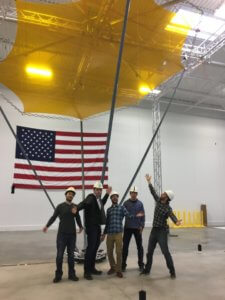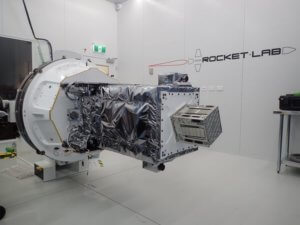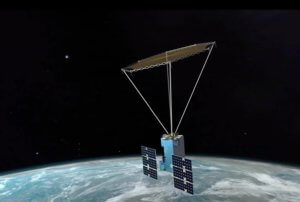MMA Demonstrates Agility with Rapid Spacecraft Development on the RF Risk Reduction Deployment Demonstration “R3D2” Mission by Going from Concept to Spaceflight in 20 Months
As a small, agile team since our infancy, MMA has always found distinction in our ability to learn faster, work leaner, and iterate to deliver hardware more quickly than many of our contemporaries. So, when DARPA and Northrop Grumman approached us to adapt our P-DaHGR (pantograph deployable high-gain reflectarray) antenna concept for the R3D2 mission, it was time to put the pedal to our mettle.

5-meter P-DaHGR team celebrating a successful deployment.
We had already built a 5-meter P-DaHGR antenna, leveraging our learnings from other concepts and programs over the years. Our toolkit of thin-film membranes, pantographs, composite tapes and tape deployers, among other high-TRL subsystems, were the building blocks we scaled, adapted, tested and expeditiously put to task.

R3D2 stowed and ready to launch.
The R3D2 antenna, a 2.25-meter version of the same P-DaHGR architecture that stows in a 10U volume (2,250 m/m3), went from CAD to low earth orbit in just 20 months, launching on a RocketLab Electron rocket in March of 2019, even while enduring the battery of tests required to reduce risk.
But speed was not the only critical metric on this mission. By compacting a large antenna into a small satellite with our unique membrane-based design, the spacecraft could provide significant RF sensor capability, without the need for large satellites that can only be launched on big rockets with hefty price tags.

Rendering of R3D2 on orbit courtesy of Northrop Grumman.
We like to say that we think out of the box to put more into the box for our customers, and this collaboration on the R3D2 mission — with partners like DARPA and Northrop Grumman who share our passion for innovation and exploration — demonstrates this beautifully.


